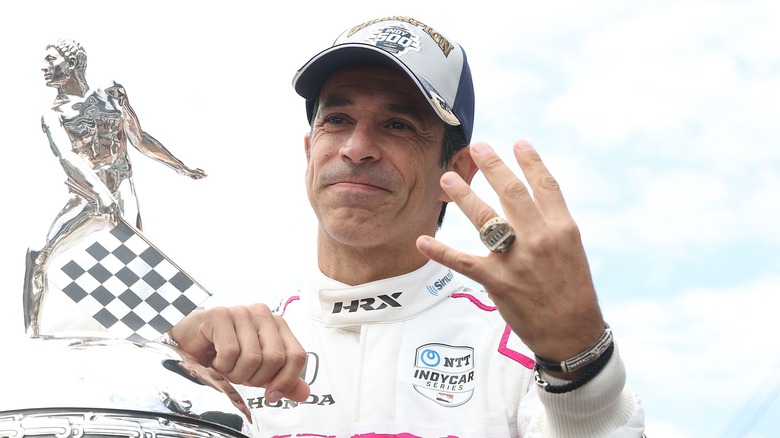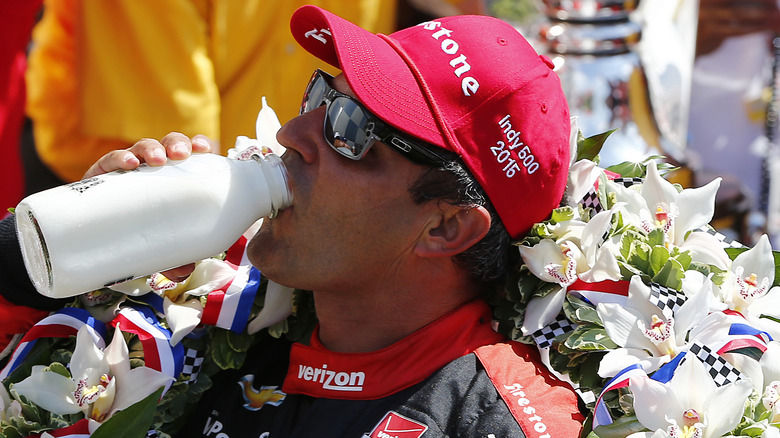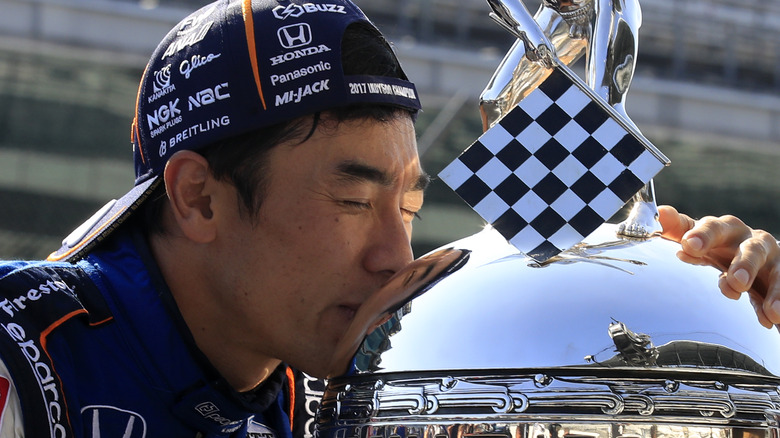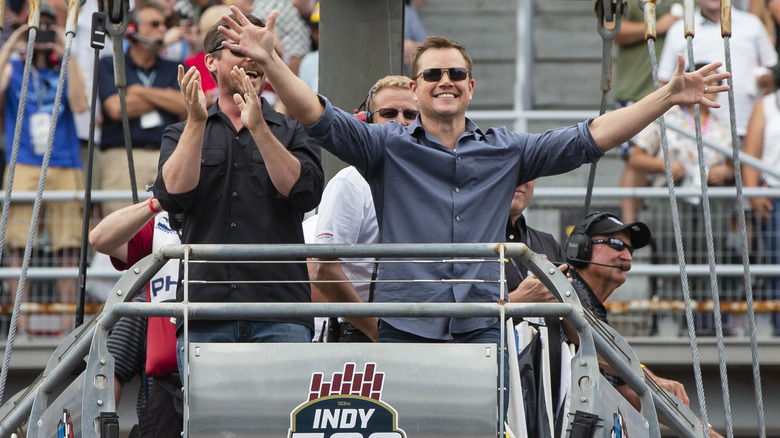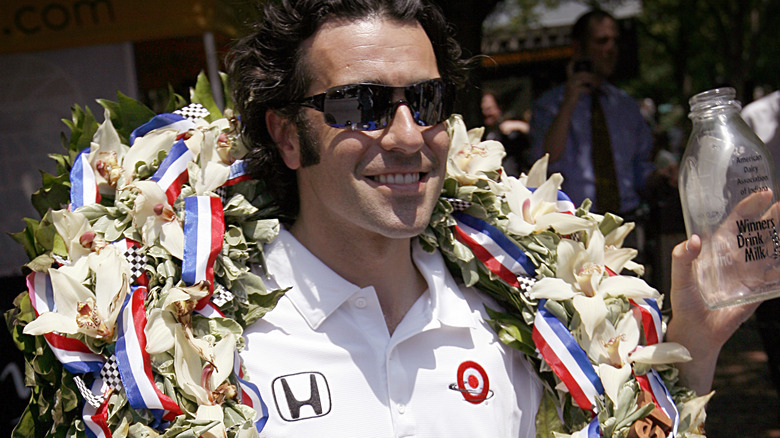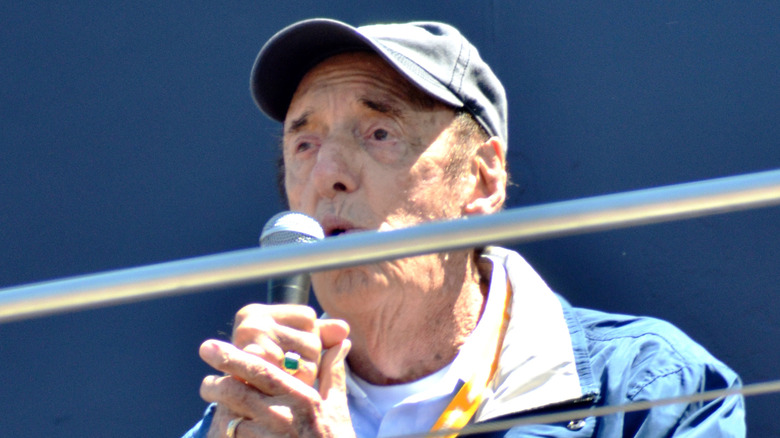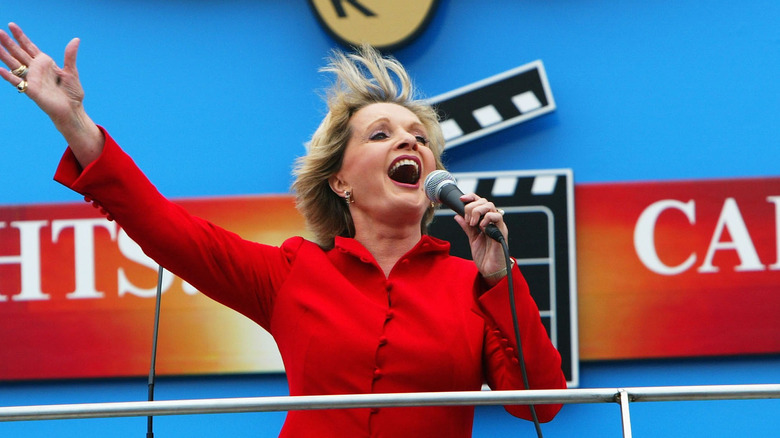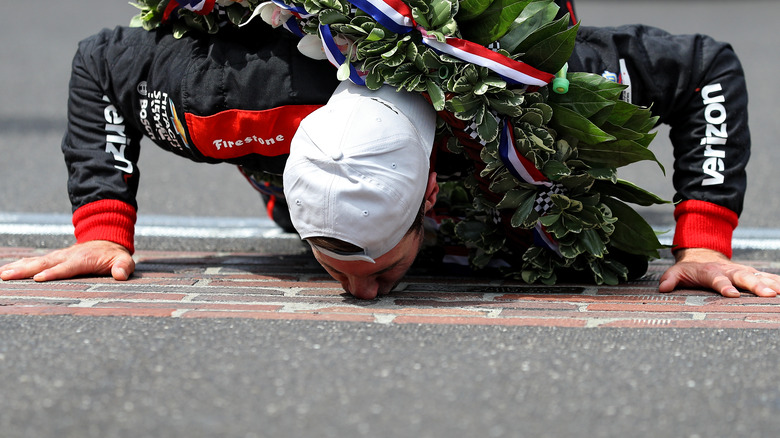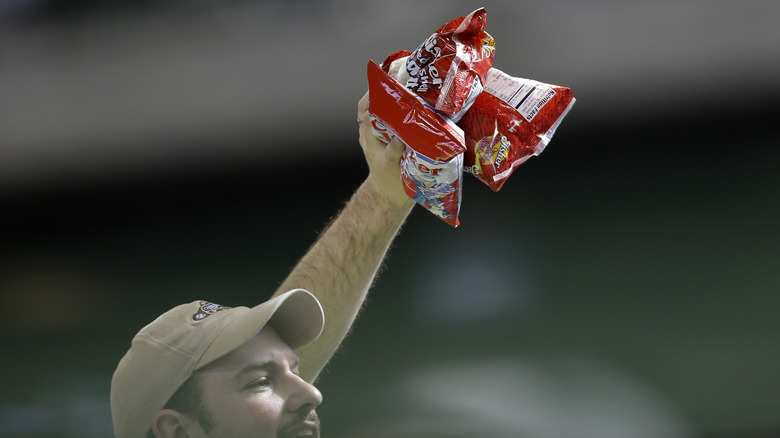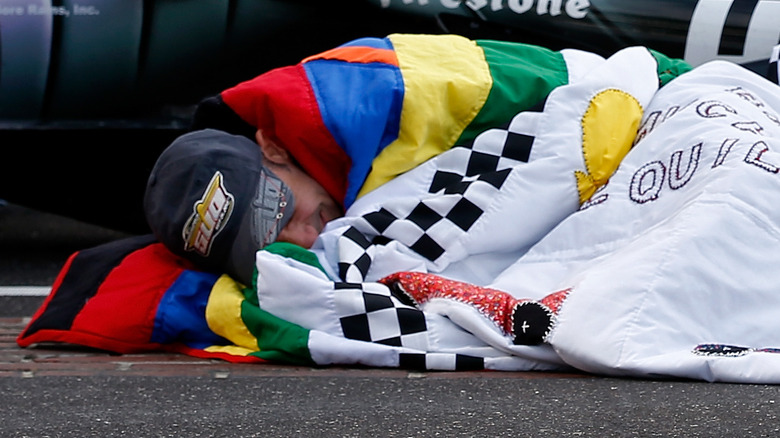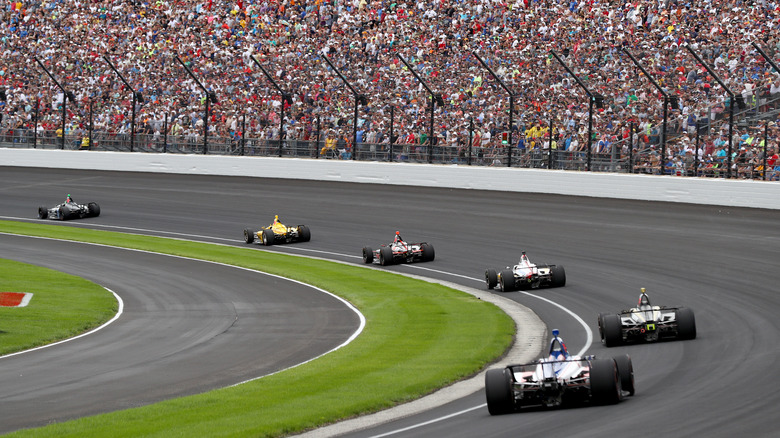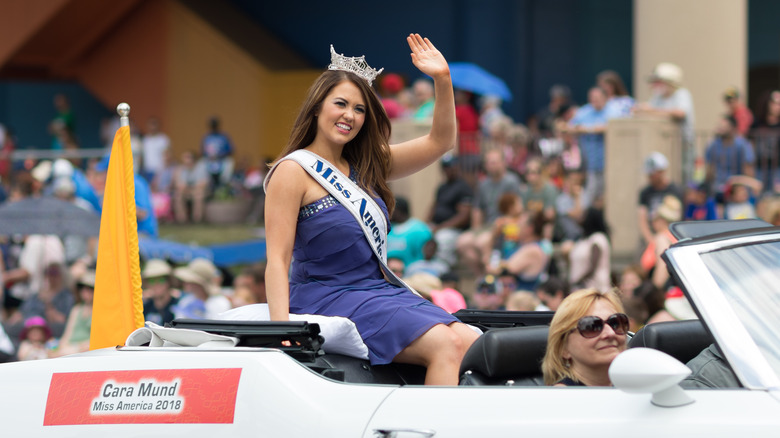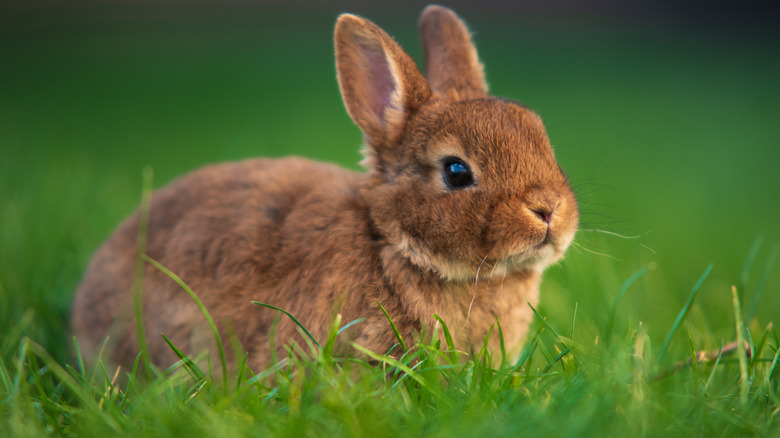The Indy 500's Biggest Traditions And Lore Explained
The Indianapolis 500, or the Indy 500, is one of the most famous and intensely watched individual events in motorsports and American sports. Occurring each May at the Indianapolis Motor Speedway in Indiana's capital city, it ranks with the Super Bowl, FIFA World Cup final, and the Kentucky Derby as a towering spectacle of sports, competition, and endurance, a 200-lap, 500-mile race around an oval track contested by expert drivers piloting state-of-the-art vehicles traveling at almost unbelievable speeds.
Since running almost every Memorial Day weekend for more than a century, the Indianapolis 500 is bursting with history, with nearly every moment both before and after the otherwise unpredictable, wicked-fast IndyCar circuit signature race carefully planned out and observed, each beloved and warmly anticipated act a nod to the hundred years of racing that preceded. Here are the most notable, best-liked, and most enchanting traditions associated with the Indy 500 and how they all started and took hold.
Why the winner drinks milk
A fully-clothed shower of some kind of drinkable substance is a tradition that crosses the boundaries of sports. Big game-winning football coaches get doused with a tanker of sports drinks, NBA title winners spray one another with champagne, and the winner of the Indianapolis 500 pours a bottle of cold, white, fatty milk all over themselves. According to the historians of the Indianapolis Motor Speedway, site of the Indy 500 (via USA Today), it's a quirky rite originated by three-time winner Louis Meyer.
A major driver in the 1920s and 1930s, Meyer won the 1936 running of the Indy 500, and after spending most of a hot day inside a hot car, he needed to cool down, so he did what he always did when he overheated during racing: He drank a bottle of buttermilk. An executive with the era's preeminent dairy products trade organization, the Milk Foundation, saw a photo of Meyer doing that in a newspaper the next day and decided to orchestrate the drinking of popular, familiar milk (not the bitter, more acquired taste-oriented buttermilk) after the Indy 500 as a tradition. Barring a period in the 1940s and 1950s when the milk-drinking went away, it's been customary since 1956 for a dairy industry rep to hand the winning driver a bottle of celebratory milk, who usually takes a few sips before dumping out the rest on his face and body.
Why the Indy 500 is held on Memorial Day weekend
The Indianapolis 500 is almost always run on the Sunday that falls during Memorial Day weekend, a major three-day break in American culture that also serves as the unofficial kickoff of summer. Why the race actually falls on such a momentous weekend goes back to the Indianapolis Motor Speedway's first full season in 1910.
According to Britannica Beyond, that year, festival-style race collections were held all across Memorial Day weekend (at the time known as Decoration Day), along with the Fourth of July and Labor Day weekends. Only the first of those three had high attendance numbers, and track management decided to limit the long weekend racing to just one big race on one day, the Indy 500, on Decoration Day, which in the 1910s always fell on May 30.
In 1911 then, Decoration Day fell on a Tuesday, and it also coincided with a local, less-official holiday. At the end of May, many members of Indiana's large farming community took a few days off after baling their hay for a year, and a big race could be a great way to spend some of that off-time. When Decoration Day became Memorial Day and was fixed to the final Monday in May, race organizers planted the Indy 500 on the day before, officially making the move in 1974.
Why the gentlemen start their engines
It's probably the most famous line in all of American sport (and a disarmingly charming and low-key one at that), proclaiming slowly and cautiously that a massively fast car race can and should begin. At the outset of the Indianapolis 500 each year, a prominent individual (the race's ceremonial grand marshal) gets to utter the words, "Gentlemen, start your engines! ("Ladies" is added to the salvo when appropriate, when a female driver competes in the historically overwhelmingly male-dominated race).
How and when the catchphrase began is something of a mystery, according to the Indianapolis Motor Speedway. According to one account, track president Wilbur Shaw hired his friend John "Irish" Horan, a stunt show promoter and carnival barker, in 1948 to be the raceway's public address announcer. Several race fans reportedly approached Horan with the idea to say something big at the beginning of the Indy 500, and he may have done so for the first time in either 1949 or 1950, likely quipping, "Gentlemen, start your motors." However, Shaw said in his memoirs that he had said the phrase, but with "engines" instead of "motors," as early as 1946, but records show he didn't take over that duty until 1953.
Why 33 cars start at the Indy 500
Many numbers factor prominently into the traditions, history, and annual operations of the Indianapolis 500, such as 200 (the amount of laps that comprise a 500-mile race) and 33, the number of drivers who comprise each year's participant grid. It's a very specific number of drivers, and race organizers came to that figure out of a concern for safety way back in the early days of the Indy 500.
According to Jalopnik, the first Indianapolis 500 in 1911 saw 40 drivers compete, which left organizers with a sense that the track was overcrowded, if not dangerous. The body that oversaw the race at the time, AAA's Contest Board, devised a formula to figure out the safest but largest number of races possible. Figuring that each car should require 400 feet of track on a 2.5 mile course at the Indianapolis Motor Speedway, that works out to a maximum of 33 cars. However, only 30 drivers raced until 1915, and during the Great Depression of the 1930s, the Speedway tried to bolster the proceedings by letting as many as 42 cars onto the track at once.
That "33" shows up in the Indianapolis 500 winner's wreath, too. It's adorned with 33 small Cymbidium orchids and 33 tiny checkered racing flags.
Why they sing (Back Home Again in) Indiana
The official Indiana state song is "On the Banks of the Wabash, Far Away," but it's not the tune sung each year during the pre-race festivities of the Indianapolis 500. That designation goes to "(Back Home Again in) Indiana," a standard dating to 1917. In 1946, New York Metropolitan Opera star (and auto enthusiast) James Melton was in attendance at the race, and before the cars started zooming, he asked to sing "(Back Home Again) in Indiana" to the crowd, a sentimental gesture for the first running of the Indy 500 after a four-year hiatus caused by World War II. It got a great response, so Melton obliged when race organizers asked him to sing it again the following year.
In the 1970s, singing "Indiana" became the signature public act of TV sitcom star Jim Nabors. In contrast to his work on "The Andy Griffith Show" and "Gomer Pyle U.S.M.C.," Nabors boasted a velvety baritone, near operatic singing voice that he employed on numerous albums and variety shows, according to IndyStar. He attended the 1972 Indy 500 on the pretense to perform "The Star-Spangled Banner," but just hours before the race began, Indianapolis Motor Speedway owner Tony Hulman asked Nabors to sing "Indiana" instead. "I wrote down the song so I wouldn't screw it up — wrote it down on my hand," Nabors once said of the first time singing "Indiana" publicly, which he did most every year until 2014, according to ESPN.
Why Florence Henderson is so important to the Indy 500
Jim Nabors wasn't the only veteran of iconically corny 1960s and 1970s television who became an Indianapolis 500 institution. The pre-race musical activities include "(Back Home Again in) Indiana" to honor the Indy 500's home state, as well as a well-known patriotic song to pay tribute to the United States, be it "America the Beautiful," "God Bless America," or "The Star-Spangled Banner." And 23 times, between 1991 and 2015, according to USA Today, the singing of the national anthem or its alternates was handled by actor and musical theater performer Florence Henderson, best known for her role as Carol Brady on the sitcom "The Brady Bunch." The connection between the Indy 500 and the TV legend was direct and local — Henderson was born in Dale, a small town in Southern Indiana, the tenth child in a tobacco farming family.
Henderson's last connection to the Indianapolis 500 came in May 2016, when she served as the grand marshal of the race, about six months before she died at age 82. According to the Indianapolis Motor Speedway, Henderson always refused all payment for her performance and even spent a lot of her own money at the IMS gift store buying souvenirs for friends and relatives during shopping sprees with Nabors.
Why the winning driver kisses the bricks
Millions of paving bricks help comprise the racing surface and surrounding areas of the Indianapolis Motor Speedway. According to the track's website, 3.2 million paving bricks sit atop crushed rock and tar, and by 1961, asphalt had covered almost all of them, leaving behind a 36-inch-wide section at the starting line / finishing line, a piece of physical, red-and-gray racing history known as the Yard of Bricks.
Every Indianapolis 500 winner (and participant) has driven their vehicle over those important bricks, and as a show of respect to his predecessors, NASCAR champ Dale Jarrett pioneered the tradition of kissing the bricks. Just after winning the 1996 racing of the Brickyard 400 at the Indianapolis Motor Speedway, Jarrett and his crew chief, Todd Parrott, walked back out to the track, got on their knees, and puckered up to the racing surface. It's now tradition for winners of both the Brickyard 400 and Indianapolis 500 to follow suit.
Why they used to not serve peanuts at the Indy 500
Nearly everyone who isn't deathly allergic to peanuts can agree on them — they're a great spectator snack for sporting events, and they're served at virtually everything sporting events in the United States, so synonymous with in-the-stands eating that they're immortalized in "Take Me Out to the Ball Game," in which the narrator wishes to consume "peanuts and Cracker Jack." Probably the biggest sports gathering where peanuts were not an option: the Indianapolis 500. Paying, ticketed entrants could buy and eat any number of comestibles during the big annual race at the Indianapolis Motor Speedway, but for decades, not peanuts.
According to Racing Nation and WFYI Indianapolis, the peanut ban can be traced to a likely apocryphal story about a crash (with no specific dates or names attached) that happened during the Indy 500 in the 1940s, after the race resumed after a World War II interruption. In the fiery, winged remains of the wrecked automobile, investigators discovered peanut shells. Not necessarily causing the crash but portending doom nonetheless, track officials banned peanuts from the Indy 500 for decades. The Indianapolis Motor Speedway started selling them again on race day, albeit quietly, sometime in the 21st century.
Why the winner gets a quilt
Winning the Indianapolis 500 brings a race car driver glory, fame, a permanent spot in the sports history books, as well as some more tangible things like money and stuff. According to Motorsport, every driver gets a sum based on their finishing position, with the victorious driver getting the biggest piece, around 20 percent of the multimillion-dollar pot. Also, their image is hammered into the Borg-Warner Trophy and they get a brand new quilt. Yes, a quilt, a humble, homemade, one-of-a-kind prize handcrafted by a local Indiana racing fan.
According to WFYI Indianapolis, Jeanetta Holder made a quilt in advance of the 1976 racing of the Indy 500 and presented her handicraft to winning driver Johnny Rutherford. Ever since, it's been part of race day, that after going through all the other post-race rituals and accolades that a driver gets their quilt on the day after the race during press and media events. Holder, now into her golden years and occasionally thwarted by an injury, still makes them herself.
Why the Indy 500 celebrates the barely qualified
During the run-up to the actual racing of the Indianapolis 500 on the Sunday of Memorial Day weekend, there are a number of surrounding events, including Thursday night's The Last Row Party. Held on the track itself, in the 160-feet-tall Pagoda that flanks the starting line and finishing line, the Indianapolis Press Club Foundation invites the public for Q&A sessions with drivers three days before they'll race in the Indy 500. But these are not the star drivers or the odds-on favorites to win or place highly in the illustrious contest, but rather the drivers in the "last row," or who just squeezed in to qualify for the Indy 500, and thus will start the race in the unfavorable back row at the starting line.
One of the most attended pre-race events, The Last Row Party offers beverages and food, but the things getting roasted are the back-row drivers, gently teased and mocked for their relative lack of driving prowess and good luck for getting as far as the Indy 500. It's also a source of charity and community outreach, as the IPCF uses the event to award journalism scholarships to worthy and needy local students.
Why there's an Indy 500 parade
A world-class, world-famous high-speed IndyCar race is just one part, although the most important part, of the Indianapolis 500 celebration that goes down each late May in Indiana. The Indy 500 raced for more than 40 years before a large community festival sprung up around it. According to the website of the 500 Festival, four men from the Indianapolis area conspired in 1957 to stage a parade and dance party to celebrate and latch onto the auto race that by then was a massive cultural phenomenon. Those powerful guys: Indianapolis mayor Alex Clark, Indianapolis Motor Speedway safety director Joe Quinn, J. Worth Baker of the Shriners, and Indianapolis Star promotions director Howard Wilcox.
The first 500 Festival event on the books was a parade in downtown Indianapolis, followed by the Governor's Ball, where 500 people paid $5 (per couple) to attend a formal dance party where Woody Herman's Orchestra played. In the 2020s, more than 150,000 people watch the parade as it happens, which is one of more than 50 events in the 500 Festival, which also includes a golf tournament, a memorial service, and a mini-marathon.
Why rabbits are so important to the Indy 500
For better or for worse, rabbits figure into the extensive lore of the Indianapolis 500. According to the Indianapolis News, rabbits historically seem to show up on the grounds around the Indianapolis Motor Speedway and spotting them is an unofficial pre-race activity. But in 1959, one of those rabbits hopped a little too far into the IMS, and just before the race, made it onto the track. A number of officials, including drivers, track employees, and mechanics, along with several spectators, tried to corral the rabbit to safety in a timely fashion. It was finally 46-year-old Dayton, Indiana, resident Cecil Sexton who chased the bunny into a car pit area and got him into a stretch of grass near the track.
Flash forward nearly 30 years, and a rabbit who wandered onto the track wouldn't experience such a happy ending. According to the Indianapolis Star, Al Unser, a four-time Indianapolis 500 winner, finished in third place, stymied into a lower finish when he was surprised by a rabbit that ran onto the track, right in his driving path. He didn't have much time or recourse to do much but hit the rabbit, which flew into the air and hit the car driven by eventual winner Rick Mears.
